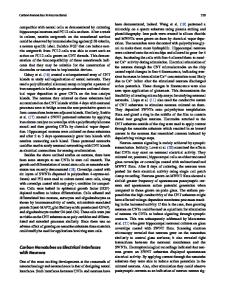In-situ Fluid Experiments in Carbon Nanotubes
- PDF / 922,527 Bytes
- 6 Pages / 612 x 792 pts (letter) Page_size
- 4 Downloads / 379 Views
In-situ Fluid Experiments in Carbon Nanotubes Yury Gogotsi1, Joseph A. Libera,2* Almila Güvenç Yazicioglu2 and Constantine M. Megaridis2 1 Department of Materials Engineering, Drexel University, Philadelphia, PA 19104, USA 2 Department of Mechanical Engineering, University of Illinois at Chicago, Chicago, IL 606077022, USA ABSTRACT Closed-end multi-wall carbon nanotubes, which contain an encapsulated aqueous multiphase fluid under high pressure, have been produced by hydrothermal synthesis. These nanotubes are leak-tight by virtue of holding the fluid at the high vacuum of a transmission electron microscope (TEM) and can be used as a test platform for unique in-situ nanofluidic experiments in TEM. They form an experimental apparatus, which is at least two orders of magnitude smaller than the smallest capillaries used in fluidic experiments so far. Excellent wettability of the carbon tube walls by the liquid and a dynamic behavior similar to that in microcapillaries demonstrates the possibility of use of nanoscale (TA
TC >TB
Gas
A
Liquid
B TE >T D
TD >TC
D
C
E
TF >T E
F
Figure 1. TEM micrographs of a typical carbon nanotube with a water-based fluid membrane inclusion. The meniscus shows good wettability of carbon by the water-based fluid. The contraction of the liquid inclusion upon heating, as shown in (A,B), was reversible. (A) Initial shape, (B), (C) inclusion gets gradually thinner upon heating, until it breaks off near the center (D). The ring of liquid, formed as a result of this rupture event (E), gradually spreads uniformly along the walls forming a thin annular film (F), which reaches a few nanometers in thickness and eventually disappears.
A7.4.2
nanotubes produced in vacuum or at ambient pressure, frequently contain an aqueous fluid and gases encapsulated under pressure. The presence of H2O, CO, CO2, H2 and CH4 is expected from thermodynamic calculations done using the ChemSage-3.1 Gibbs energy minimization code (11). Water and gases were present in the synthesis capsules and it is logical to assume that the composition of the fluid inside and outside the tubes is approximately the same. If we consider that a tube was closed at 750ºC and hydrothermal fluid was captured at this temperature, the pressure in the tube at room temperature should be at maximum ~30 MPa. The inner pressure would be lower if the tube closed at a temperature below 750ºC. High pressures are known to facilitate increased solubility of gases in liquids. This must be taken into account in the interpretation of the observed phenomena. The demonstrated ability of hydrothermal nanotubes to act as miniature pressure vessels and to maintain the pressurized fluid even when heated under the high vacuum of the TEM column (10-8 torr) confirms their very high strength and wall perfection.
Bubbles Vacuum
Liquid Gas 50 nm Figure 2. TEM micrographs showing a liquid inclusion restricted by a rare internal tube closure after heating with the electron beam. Bubble-like formations are the result of evaporation of the aqueous fluid at th
Data Loading...











